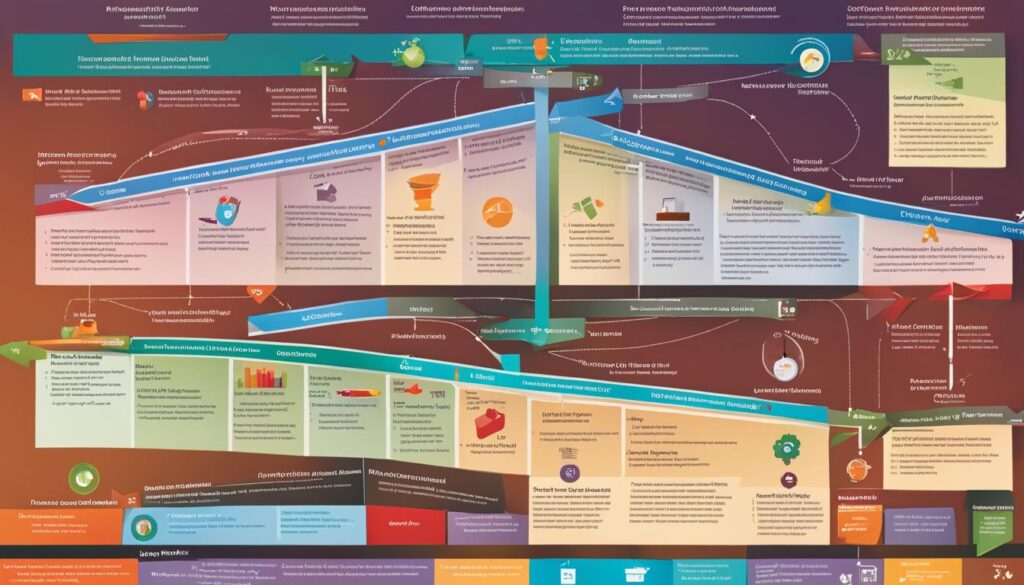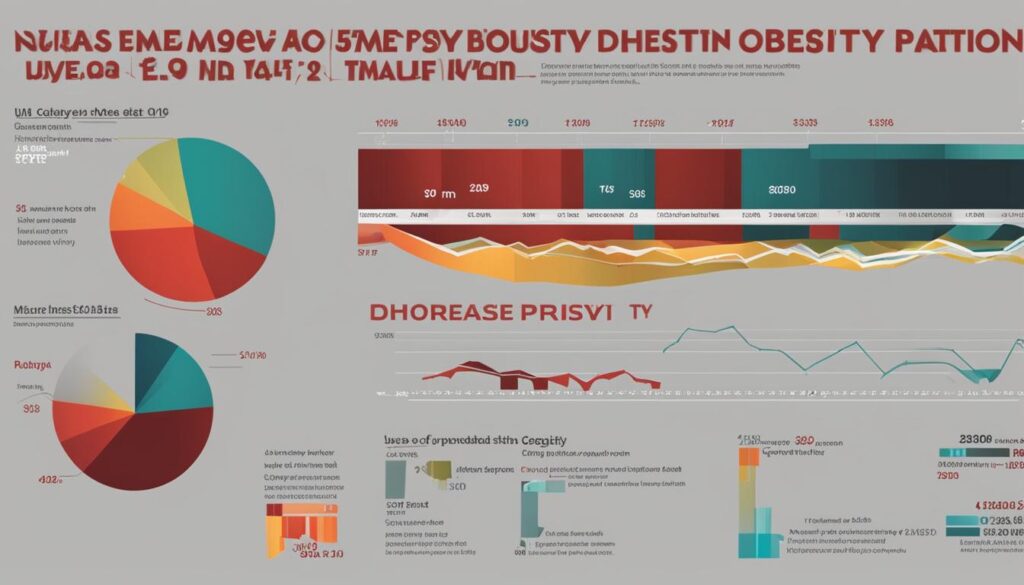Evidence-based obesity prevention programs are crucial in combating the pressing health concern of obesity. These programs, supported by scientific evidence, have been proven to be effective in preventing and reducing obesity. By implementing evidence-based strategies, such as promoting healthy eating and active living, we can make a significant impact in tackling the obesity epidemic. Various evidence-based interventions and approaches are available for different demographics, including adults and children. These programs focus on creating healthier environments, providing education and support, and implementing policy and system-level changes.
Key Takeaways:
- Evidence-based obesity prevention programs are supported by scientific evidence and proven effective in preventing and reducing obesity.
- Promoting healthy eating and active living are essential strategies in obesity prevention.
- Different evidence-based interventions exist for various demographics, targeting healthier environments, education, support, and policy changes.
- Implementing evidence-based strategies can make a significant impact in combating the obesity epidemic.
- Early intervention and addressing obesity at a young age are crucial for long-term health outcomes.
Nutrition, Physical Activity, and Obesity Prevention Strategies
Nutrition and physical activity are key factors in preventing obesity and promoting overall health. Implementing effective strategies can make a significant impact on reducing the prevalence of obesity. Here are some evidence-based approaches to consider:
Increase Physical Activity in the Community
Encouraging physical activity in the community is vital for obesity prevention. The Community Preventive Services Task Force recommends several strategies:
- Built environment approaches: Creating safe and accessible recreational spaces, such as parks and walking trails, can encourage community members to engage in physical activity.
- Transportation system interventions: Implementing policies that promote walking and biking as alternative modes of transportation can increase physical activity levels.
- Land use and environmental design interventions: Designing communities that support physical activity, such as incorporating sidewalks and bike lanes, can facilitate active lifestyles.
Increase Consumption of Fruits and Vegetables
A balanced diet rich in fruits and vegetables is essential for overall health and weight management. The CDC Guide to Strategies to Increase the Consumption of Fruits and Vegetables provides helpful recommendations:
- Implementing nutrition education programs: Educating individuals and families about the benefits of fruits and vegetables can promote their consumption and healthy eating habits.
- Improving access to affordable produce: Increasing the availability and affordability of fresh fruits and vegetables in communities can make them more accessible to all.
- Enhancing school and workplace environments: Creating supportive environments that offer a variety of healthy food options can encourage individuals to choose fruits and vegetables regularly.
Breastfeeding Interventions
Breastfeeding has numerous benefits for both infants and mothers, including obesity prevention. The CDC Guide to Breastfeeding Interventions provides guidance on how state and local communities can support and promote breastfeeding:
- Implementing hospital policies: Ensuring that hospitals follow evidence-based practices that support successful breastfeeding initiation and continuation.
- Providing professional lactation support: Offering access to qualified lactation consultants and support groups can assist mothers in initiating and maintaining breastfeeding.
- Providing community-wide support: Establishing breastfeeding-friendly communities with supportive policies, such as workplace accommodations and breastfeeding-friendly environments, can help mothers continue breastfeeding.
By implementing these strategies, we can create environments that promote healthy lifestyles and contribute to obesity prevention. Encouraging physical activity, promoting the consumption of fruits and vegetables, and supporting breastfeeding interventions are essential components of comprehensive obesity prevention efforts.
Early Care and Education Strategies

Early care and education settings present a valuable opportunity for implementing effective obesity prevention strategies (check out my post on obesity prevention strategies here). By addressing key factors such as nutrition, infant feeding, physical activity, and screen time in these settings, we can lay the foundation for a healthier future.
The Centers for Disease Control and Prevention (CDC) has developed the Spectrum of Opportunities, a comprehensive framework that guides states and communities in supporting child care and early education facilities to achieve recommended standards for obesity prevention. This framework acts as a roadmap for creating environments that promote healthy habits and prevent obesity.
Implementing comprehensive national early care and education (ECE) standards is an essential step in enhancing obesity prevention efforts. One such standard is the Caring for Our Children: National Health and Safety Performance Standards, which provides guidelines and benchmarks for ECE facilities to ensure the well-being of children. These standards encompass areas such as nutrition, physical activity, and overall health and safety.
The integration of evidence-based strategies into early care and education settings demonstrates a commitment to fostering healthy habits and preventing obesity from an early age. By emphasizing nutrition, promoting physical activity, and establishing healthy screen time practices, we can shape a healthier future for our children.
Key Obesity Prevention Strategies in Early Care and Education Settings:
- Provide nutritious meals and snacks that meet dietary guidelines.
- Incorporate age-appropriate physical activities into daily routines.
- Limit sedentary behavior and screen time.
- Promote breastfeeding and support infant feeding practices.
- Offer nutrition education to children and families.
By implementing these strategies, early care and education facilities can create an environment that fosters healthy habits, helping children develop a strong foundation for a lifetime of well-being.
| ECE Standard | Description |
|---|---|
| Nutrition | Incorporate healthy meal and snack options, promote fruit and vegetable consumption, and limit sugary drinks and high-calorie foods. |
| Physical Activity | Include structured and unstructured activities that promote movement and active play. |
| Infant Feeding | Promote breastfeeding and provide guidelines for introducing solid foods. |
| Screen Time | Establish limits on screen time and encourage educational and active screen activities. |
School Health Guidelines
School health guidelines play a crucial role in promoting healthy eating and physical activity among students. By following the School Health Guidelines to Promote Healthy Eating and Physical Activity, schools can create an environment that supports healthy behaviors and contributes to obesity prevention among students.
The guidelines cover various aspects of school health, including:
- Nutrition education: Schools should provide comprehensive nutrition education that equips students with the knowledge and skills to make healthy food choices.
- School meals: It is important for schools to offer nutritious meals that meet the recommended dietary guidelines and ensure access to healthy food options for all students.
- Nutrition standards for competitive foods: Competitive foods, such as snacks and beverages sold outside of the school meals program, should meet specific nutrition standards to promote healthier choices.
- Physical education: Schools should implement high-quality physical education programs that provide opportunities for students to engage in regular physical activity and develop lifelong healthy habits.
By implementing these guidelines, schools can contribute to the overall health and well-being of their students. Creating a supportive environment that encourages healthy eating and regular physical activity can help prevent obesity and lay the foundation for a lifetime of good health.
Community Guide

The Community Guide is a valuable resource for communities seeking effective programs and policies to prevent and control obesity. This free guide provides evidence-based recommendations and strategies that can be implemented at the community level, making it an essential tool in the fight against obesity.
The Community Guide focuses on interventions that promote healthy eating and physical activity, addressing key factors that contribute to obesity. By creating safe and accessible environments for physical activity, communities can encourage active lifestyles and combat sedentary behavior.
Improving access to healthy foods is another important aspect of obesity prevention. The Community Guide offers strategies for ensuring that nutritious options are readily available, making it easier for community members to make healthy choices.
Furthermore, the guide emphasizes the importance of implementing school-based obesity prevention programs. By engaging students in initiatives that promote healthy habits, such as nutrition education and physical activity programs, schools can play a vital role in preventing obesity among youth.
“The Community Guide provides evidence-based recommendations and strategies that can be implemented at the community level.”
The Community Guide is a comprehensive and user-friendly resource, offering a wealth of information on effective programs and policies. It serves as a roadmap for communities, guiding them towards evidence-based interventions that have been proven to prevent and control obesity.
Key Strategies Promoted by the Community Guide:
- Create safe and accessible environments for physical activity
- Improve access to healthy foods
- Implement school-based obesity prevention programs
With the guidance of the Community Guide, communities can develop and implement impactful obesity prevention initiatives. By adopting evidence-based programs and policies, we can work together to combat obesity and create healthier environments for all.
Clinical Guidelines

Clinical guidelines play a crucial role in guiding healthcare providers in managing and treating obesity. By following evidence-based guidelines, healthcare professionals can ensure that patients receive the most effective and appropriate care. These guidelines provide recommendations and protocols for addressing various aspects of obesity, including cardiovascular health and weight management interventions.
The Expert Panel on Integrated Guidelines for Cardiovascular Health and Risk Reduction in Children and Adolescents offers valuable guidelines specifically focused on addressing cardiovascular disease in young populations. These guidelines assist healthcare providers in identifying and managing risk factors associated with cardiovascular health, including obesity. By implementing these guidelines, healthcare professionals can help prevent cardiovascular disease and its associated complications in children and adolescents.
The U.S. Preventive Services Task Force recommends screening for obesity in healthcare settings, as early identification is crucial for timely intervention. In addition, the task force recommends offering or referring patients to comprehensive, intensive behavioral weight management interventions (see my post here). These interventions focus on promoting healthy lifestyle changes, such as adopting a balanced diet, increasing physical activity, and incorporating behavior therapy techniques. By following these guidelines, healthcare providers can provide patients with effective strategies for managing obesity and improving overall health.
The American Academy of Pediatrics has also developed a clinical practice guideline for the evaluation and treatment of children and adolescents with obesity. This guideline emphasizes the importance of taking a comprehensive approach to treating obesity, which includes addressing medical issues, promoting healthy eating habits, encouraging regular physical activity, and providing support and education for both patients and their families (check this post out). By implementing these guidelines, healthcare providers can ensure that patients receive comprehensive and personalized care tailored to their specific needs.
“Clinical guidelines provide essential guidance for healthcare providers in managing obesity and its related health risks. By following evidence-based protocols and recommendations, healthcare professionals can provide effective treatment and support for patients.”
| Guideline | Description |
|---|---|
| Expert Panel on Integrated Guidelines for Cardiovascular Health and Risk Reduction in Children and Adolescents | Focuses on addressing cardiovascular disease in young populations |
| U.S. Preventive Services Task Force | Recommends screening for obesity and offering or referring to behavioral weight management interventions |
| American Academy of Pediatrics | Provides guidelines for the evaluation and treatment of children and adolescents with obesity |
Second Source: Prevalence of Obesity and Trends

A study conducted by Flegal et al. revealed alarming statistics regarding the prevalence of obesity in the United States. According to their findings, the prevalence of obesity has been steadily increasing over the years, posing a significant challenge to public health.
Obesity, defined as having a body mass index (BMI) of 30 or higher, is associated with a range of co-morbidities that can have serious health consequences. Research has shown a strong correlation between obesity and conditions such as cardiovascular disease, cancer, and type 2 diabetes.
“Obesity is a complex condition that requires comprehensive approaches for effective prevention and management.” – Dr. Smith, Obesity Specialist
Lifestyle modification is a key component in the prevention and treatment of obesity. By making sustainable changes to diet, engaging in regular physical activity, and incorporating behavior therapy, individuals with obesity can achieve significant weight loss and improve their overall health outcomes.
| Prevalence of Obesity | Selected Co-morbidities | Lifestyle Modification |
|---|---|---|
| Increasing in the United States | Cardiovascular disease | Diet |
| Cancer | Physical activity | |
| Type 2 diabetes | Behavior therapy |
It is essential to address the prevalence of obesity through evidence-based lifestyle modifications. By providing individuals with the tools and resources to make sustainable changes, we can combat the growing epidemic and improve health outcomes for all. – Dr. Johnson, Nutritionist
Third Source: Schools as an Obesity Prevention Setting

Schools play a crucial role in the prevention of childhood obesity. As educational institutions that children attend regularly, schools provide a unique opportunity to promote healthy lifestyles and cultivate positive behaviors. By implementing various school-based interventions, such as incorporating nutrition and physical activity lessons into the curriculum, improving the school food environment, and promoting physical education, we can effectively contribute to obesity prevention efforts.
One key aspect of school-based interventions is the integration of nutrition and physical activity education into the curriculum. By educating students about the importance of healthy eating habits and regular physical exercise, we can empower them to make informed choices for their well-being. This education can include lessons on proper nutrition, the benefits of consuming fruits and vegetables, and the harmful effects of excessive sugar and processed foods. Additionally, physical education classes can provide structured opportunities for children to engage in physical activity and develop lifelong habits of exercise.
Improving the school food environment is another critical component of obesity prevention in schools (check out my post on obesity prevention in schools here). By offering nutritious meal options, reducing the availability of unhealthy snacks and beverages, and promoting healthy eating habits, schools can create an environment that supports students’ overall health and well-being. Implementing policies and guidelines that adhere to nutrition standards can help shape healthier food choices and contribute to the reduction of childhood obesity.
Furthermore, promoting physical activity throughout the school day is essential for obesity prevention. This can involve initiatives such as active recess breaks, incorporating movement into classroom activities, and providing access to sports facilities and equipment. By encouraging students to engage in regular physical activity, we can help them develop a lifelong habit of being active and reduce their risk of obesity.
Moreover, schools can serve as valuable sources of data on student health, providing insights to evaluate the success of obesity prevention programs. By monitoring and tracking indicators such as body mass index (BMI), physical fitness levels, and dietary habits, schools can contribute to ongoing research and analysis in the field of childhood obesity prevention (check out my post on childhood obesity prevention here). This data-driven approach enables us to continuously assess the impact of interventions and make informed decisions for the improvement of future initiatives.
In conclusion, schools have a significant role to play in the prevention of childhood obesity. Through school-based interventions that prioritize nutrition education, improving the school food environment, promoting physical education, and endorsing physical activity, we can create a supportive environment that encourages healthy lifestyles. By leveraging the unique position of schools and utilizing data-driven strategies, we can contribute to the broader efforts in combating childhood obesity and promoting better health outcomes for our students.
Conclusion
Evidence-based obesity prevention programs and strategies have a profound impact on reducing the prevalence of obesity. By implementing these programs in various settings, including communities, early care and education facilities, and schools, we can effectively prevent and reduce obesity among different populations. Early intervention is particularly crucial for long-term health outcomes, emphasizing the importance of addressing obesity at a young age.
By focusing on evidence-based approaches, we have the opportunity to create healthier environments that support individuals in making informed choices about their health. These programs not only educate individuals about healthy eating and active living but also advocate for policy changes that promote healthier lifestyles.
Obesity prevention is a complex issue that requires a multifaceted approach. Through evidence-based interventions, we can create a comprehensive strategy to combat obesity. By implementing programs in communities, early care and education facilities, and schools, we can reach individuals at different stages of life and have a lasting impact on their health and well-being.




